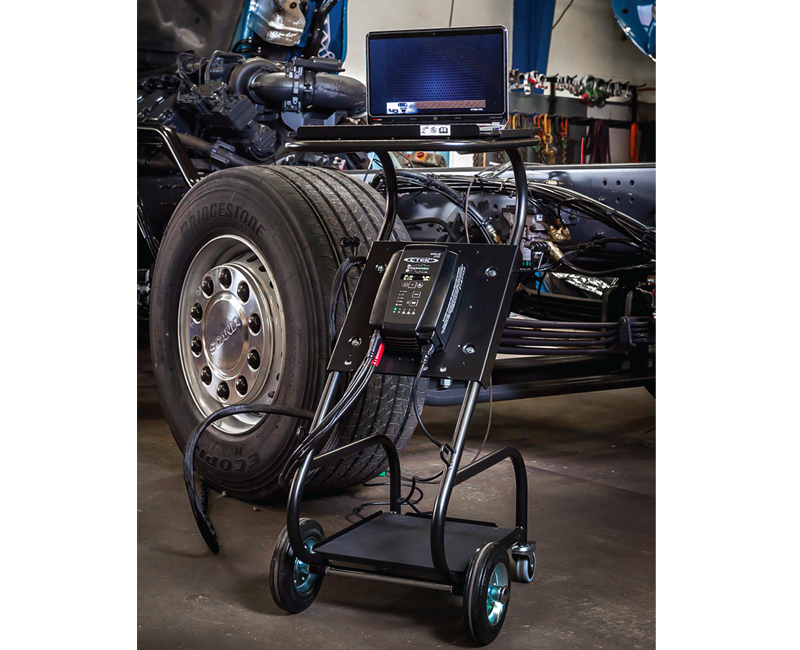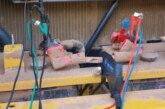Benefits of supporting the electrical system in CVs

Support the electrical system during diagnostic processes or prolonged service operations, says Ecobat Battery, and you won’t lose vital data.
As workshops and fleet operators are well aware, diagnostic procedures are now a fundamental part of commercial vehicle servicing, and during a repair, fault finding is a regular requirement in order for many issues to be resolved. Alongside this growth in diagnostic activity has come a considerable increase in the time each vehicle can be undergoing diagnostic processes, some of which include software updates that can take several hours and are therefore often scheduled to run overnight.
However, irrespective of the length of time the procedure takes, the correct voltage in the electrical system is vital to perform these functions successfully. Therefore, it is advisable to actively support the battery, and in turn the vehicle’s electrical system, not only during battery replacement, but also when running diagnostic processes and prolonged service or repair activities.
As mentioned, these procedures are linked, as to prevent causing unnecessary problems and to be carried out effectively, they all require a stable source of power, at the correct voltage, to be constantly supplied to the vehicle’s electrical system. Although, because of the well-known risk of losing stored memory data, this may seem obvious when replacing the battery, it’s not quite so universally understood when it comes to undertaking diagnostic processes, for example.
Battery discharge
However, maintaining the correct voltage during extensive periods of troubleshooting is very important, as it helps technicians to correctly identify the underlying fault. This is because during diagnostic procedures, which nowadays are commonplace, as well as most service and repair processes, the engine is switched off, but power is still drawn from the battery.
When carrying out any prolonged operation, which due to the complex electronic systems present in the modern vehicle, is not unusual, the vehicle’s control units and other electrical equipment can discharge the battery to such an extent that the on-board system voltage falls below the permissible voltage limit of the control units and a corresponding entry is made in the fault memory, and important vehicle operation data can be lost.

Like a smartphone
In truth, this reality this should come as no surprise because, as these days virtually everyone has a smart phone, all will be familiar with the fact that these will often prevent scheduled software updates from occurring if the device isn’t connected to a separate power supply, even if the battery is at more than 50%! So, a similar principle should be applied when carrying out diagnostic processes or any prolonged service action.
The power source for this supply feed however, needs to be constant and reliable, so unless it is equipped with a ‘supply only’ function, the use of a standard heavy duty smart charger isn’t recommended because, although they are very effective at charging and maintaining a battery ready for use starting the vehicle, they generally do that by constantly adjusting the charge rate, which is not what is needed when the supply must be at a consistent level.
This is where a more advanced product, such as the CTEK MXTS 40, comes to the fore, as it is a highly efficient power supply and charger, designed around the needs of the modern workshop. It has a selectable, dual voltage power supply, each with incremental output voltage settings in steps of 0.4V (12V setting) or 0.8V (24V setting).
Its steady, accurate voltage settings mean complex diagnostic, repair and reprogramming procedures can be carried out quickly and safely without fear of damage to sensitive vehicle electronics. The MXTS 40 also has automatic parallel load compensation, which makes sure that the power supply voltage and amperage are always constant and correct, even if the battery has an additional load placed on it.
The CTEK MTXS 40 is therefore a suitable power supply for diagnostic or software flashing work, procedures that require the vehicle’s ignition to be switched on for long periods of time because, using its ‘supply’ mode, maintains a constant battery voltage throughout the period of repair or reprogramming.
In summary, as has been discussed, using equipment dedicated to battery support when the vehicle is undergoing diagnostic procedures, is now a necessity. In addition, a battery performs best when it’s in peak condition, so by reducing the possibility of battery failure in the workshop, or even worse when the vehicle is back out on the road, workshops can illustrate best practice, and save time and money by reducing the likelihood of unnecessary down time.






![Bosch outlines ESI[tronic] workshop software](https://cvwmagazine.co.uk/wp-content/uploads/2025/07/Bosch-ESItronic-25-165x109.jpg)


